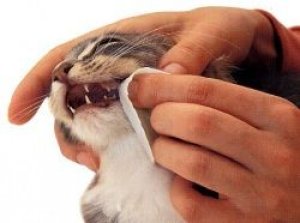
All iLive content is medically reviewed or fact checked to ensure as much factual accuracy as possible.
We have strict sourcing guidelines and only link to reputable media sites, academic research institutions and, whenever possible, medically peer reviewed studies. Note that the numbers in parentheses ([1], [2], etc.) are clickable links to these studies.
If you feel that any of our content is inaccurate, out-of-date, or otherwise questionable, please select it and press Ctrl + Enter.
Ten steps to feline dental health
Last reviewed: 04.07.2025

Even if the only thing your cat is hunting for these days is chicken-flavored kibble and toy mice, she still needs clean, sharp teeth and healthy gums. Damage to the tongue, teeth, hard palate, and gums can lead to many health risks for cats, but these can be prevented with regular at-home exams and good old-fashioned dental brushing.
- Breath test
Inhale. It shouldn't be a deep breath - cat breath doesn't smell like roses, but it shouldn't be foul either. If your cat's mouth smells unusually strong, she may have digestive problems or a gum disease like gingivitis and should be seen by a vet.
- Gums and teeth
Position the cat facing you, gently spread its lips. The gums should be firm and pink, not white or red, and should not show any signs of swelling. The teeth should be clean and free of brownish tartar, all teeth should be present, and there should be no broken teeth.
- A thorough inspection
Look for any of the following signs that may indicate problems with your cat's mouth:
- Dark red line along the gums
- Red and swollen gums
- Ulcers on the gums and tongue
- Lost teeth
- Pus
- Difficulty chewing food
- Increased salivation
- The cat touches the mouth area with its paw too often
- Dangerous inflammation
Any sign of gum inflammation should take your cat to the vet. If left untreated, gum disease can get worse and potentially lead to tooth loss and an inability to eat. Inflammation can also indicate internal problems, such as kidney disease and feline immunodeficiency virus.
- The Truth About Tooth Decay
Plaque-forming bacteria and foods can cause plaque to build up on your cat’s teeth. This can lead to tartar, potentially causing gingivitis, receding gums, and tooth loss. The solution? Regular dental brushing, of course.
- A set for cleaning your cat's teeth
All you need to brush your cat's teeth are cotton swabs, a small toothbrush, and a tube of toothpaste designed for cats. You can also use salt and water. Ask your vet to recommend a dental cleaning product they trust, and never use toothpaste designed for humans—its ingredients can be harmful to your cat.
- How to brush a cat's teeth
Brush your cat's teeth at home by following these simple steps:
- First, accustom your cat to having his teeth brushed. Start by gently massaging the gums with your fingers or touching the gums with a cotton swab.
- After a few sessions, apply a little toothpaste designed for cats to her lips so she gets used to the taste.
- Next, introduce a brush designed specifically for cats - it will be smaller than human brushes and the bristles will be softer. There are also toothbrushes available that you can put on your finger, allowing you to give your cat's gums a good massage.
- Finally, apply toothpaste to your cat's teeth and gently brush her teeth.
- An early veterinary examination will help determine if your cat's gums are inflamed. Many cats have mild gingivitis, and brushing too hard can injure their gums.
- Chewable toys
Chew toys can satisfy your cat's natural urge to chew, strengthening their teeth. Chewing on the toy can also help clean between your cat's teeth, massage the gums, and scrape away soft tartar.
- Diet for dental health
If your cat has dental problems, ask your veterinarian to recommend a food that supports your cat's dental health and helps remove plaque.
- What are the diseases of the oral cavity?
If your cat is suffering from any of the following symptoms, take her to the vet immediately:
- Gingivitis. This gum inflammation is mostly seen in older cats. It may start as a dark red line adjacent to the teeth. If left untreated, the gums may become painful and ulcers may develop. This may be a sign of feline immunodeficiency virus or another infection.
- Periodontitis. If gingivitis affects the dental alveolus, the tooth may become loose and suppuration may occur.
- Stomatitis: This inflammation of the lining of the mouth can be caused by a foreign body, a viral infection, or dental problems. The cat will have difficulty eating and the mouth will be red.
- Corrosive ulcer. A slowly enlarging sore or swelling on the upper lip.
- Salivary Gland Cyst: If the salivary glands or ducts that carry saliva into the mouth become blocked, a cyst may form under the tongue.
- Mouth ulcers: Ulcers on a cat's tongue and gums are sometimes caused by a disease in the cat's respiratory tract or kidneys.
